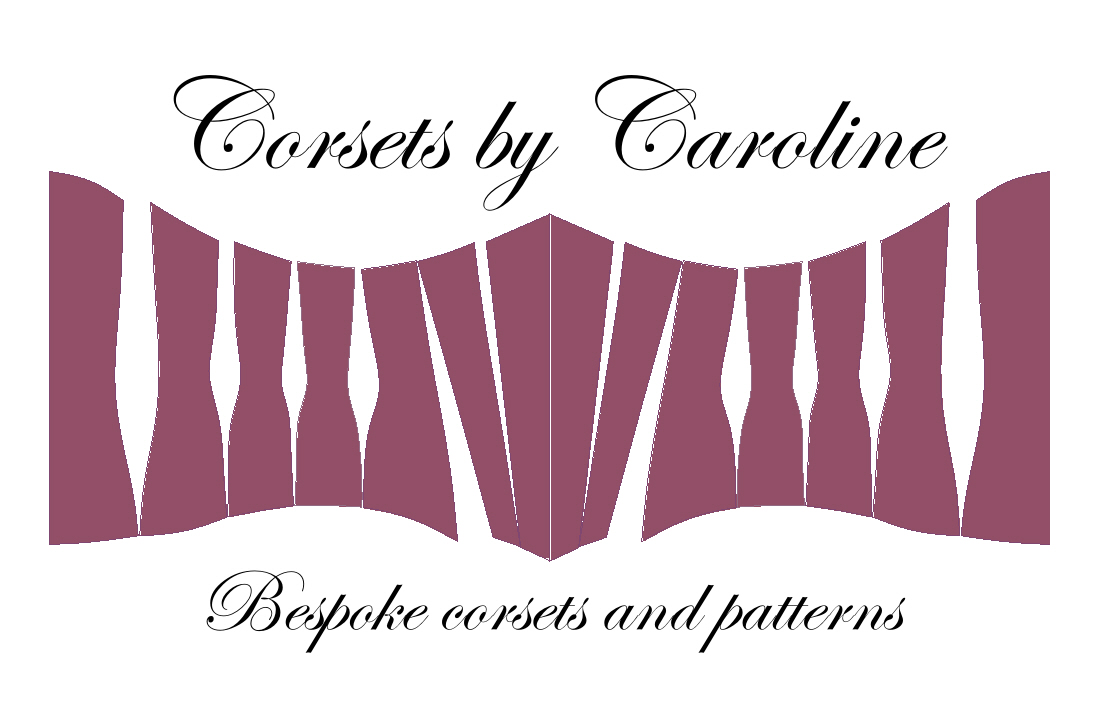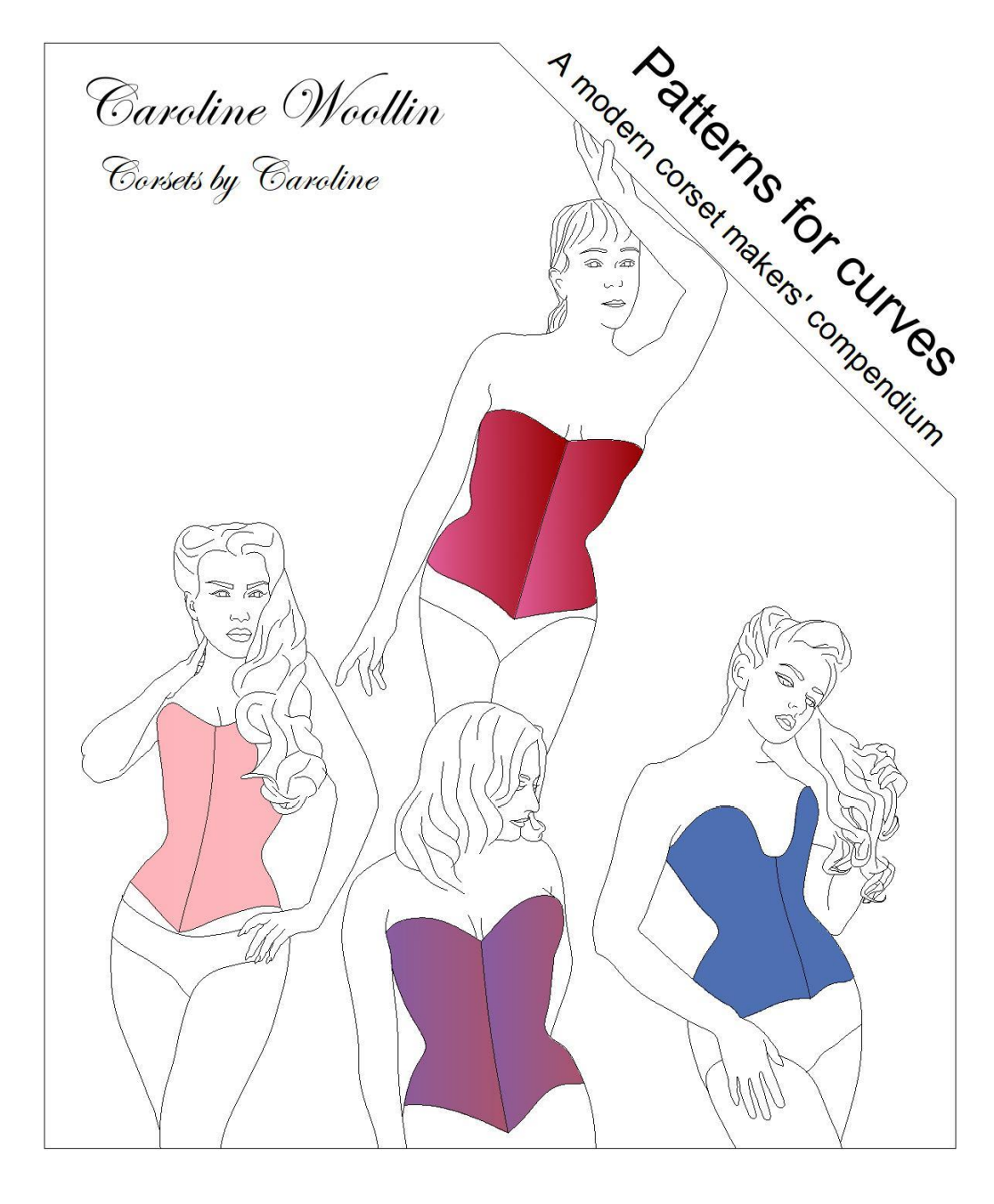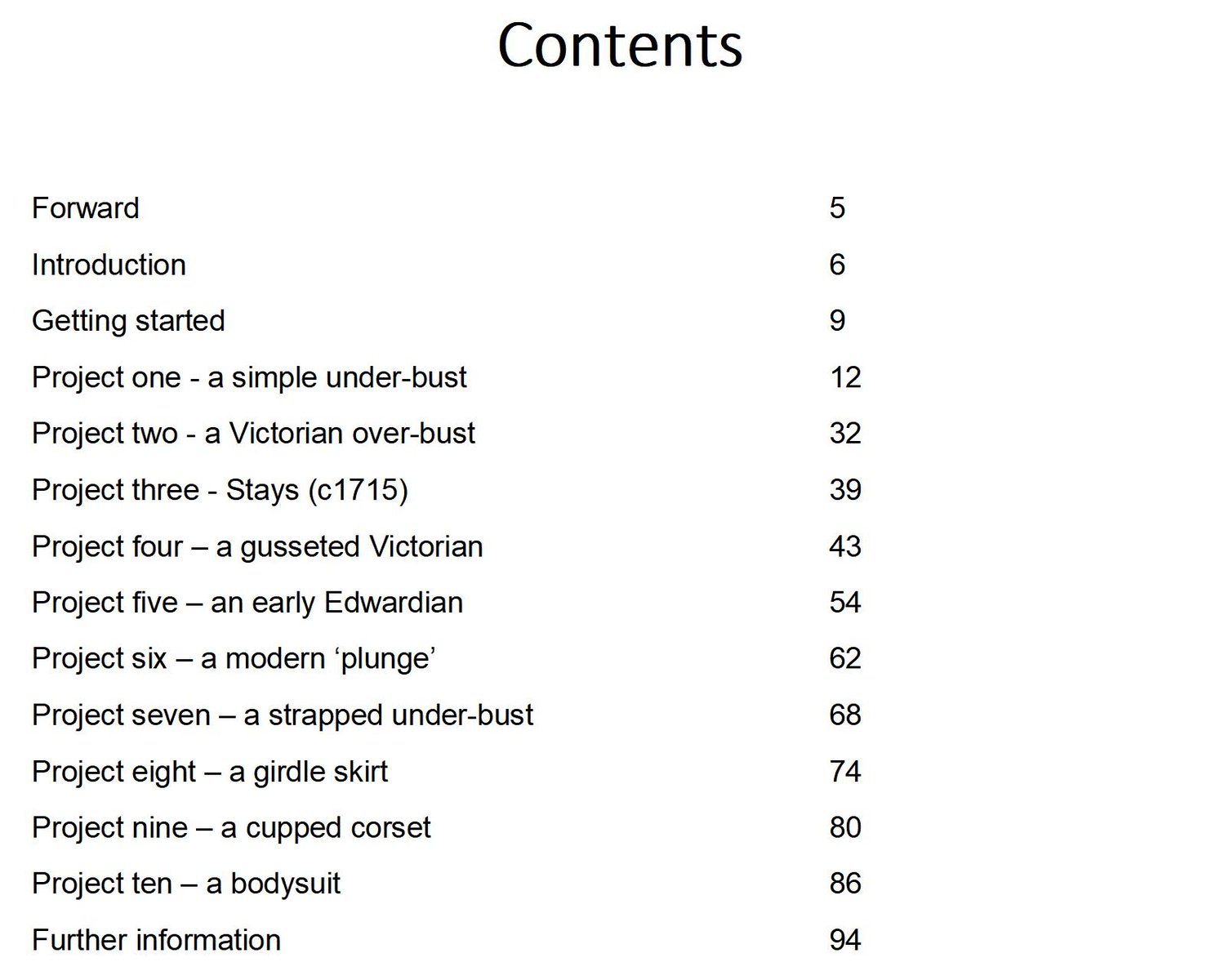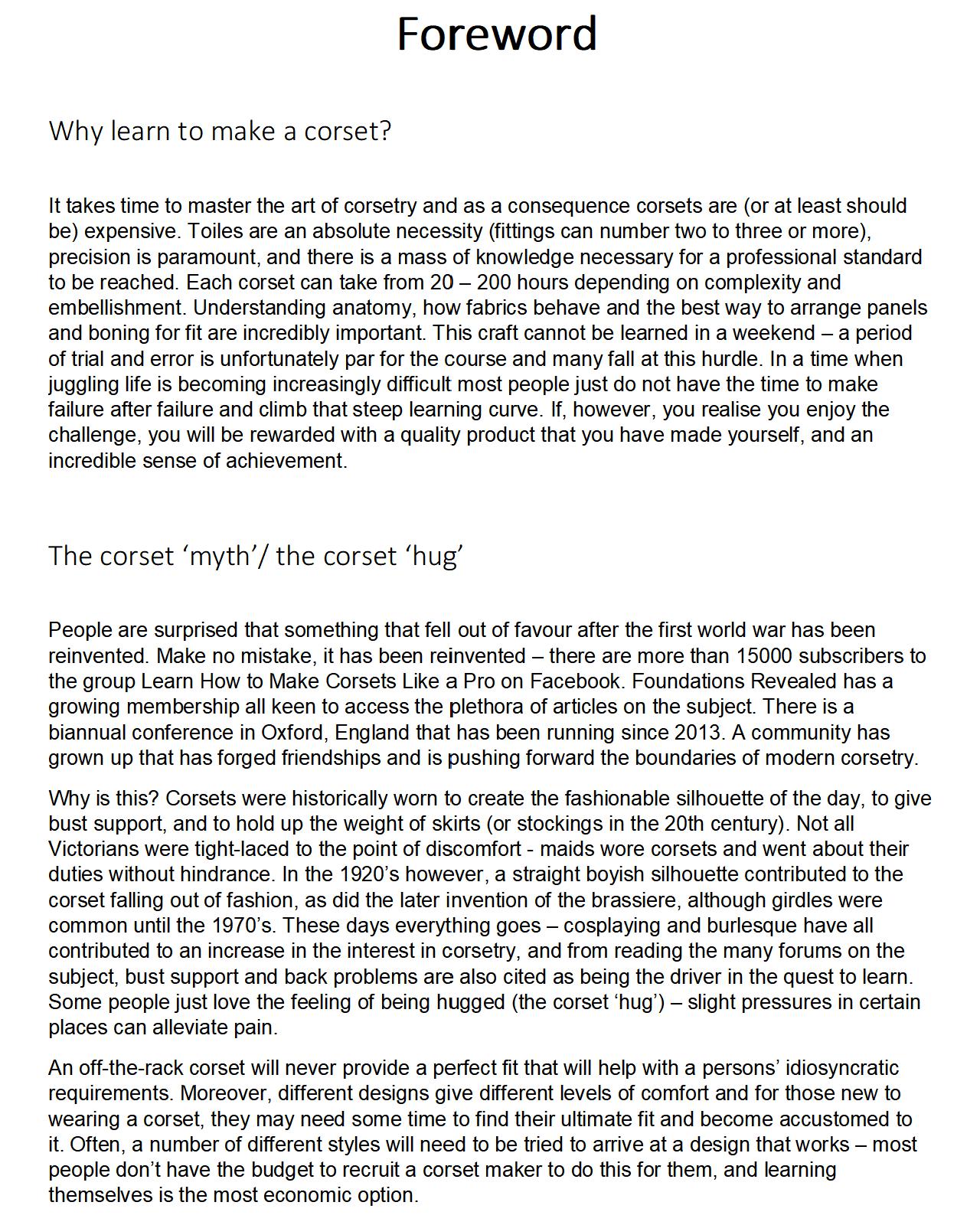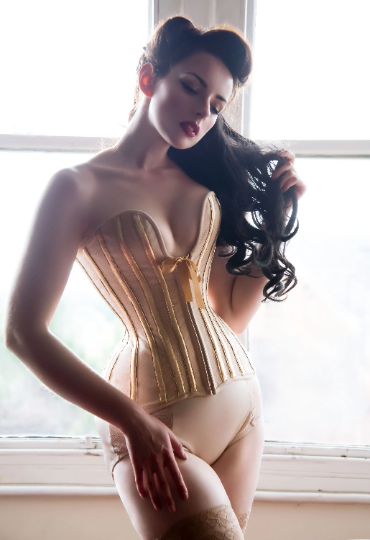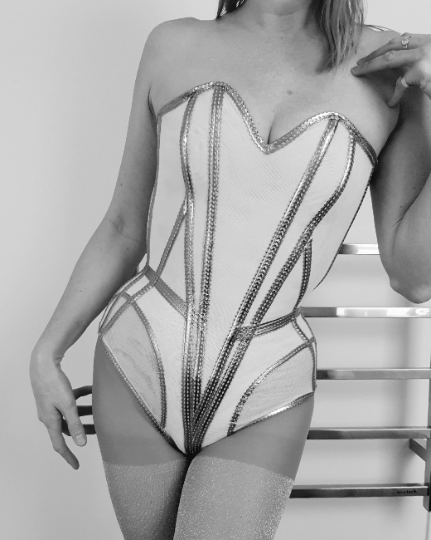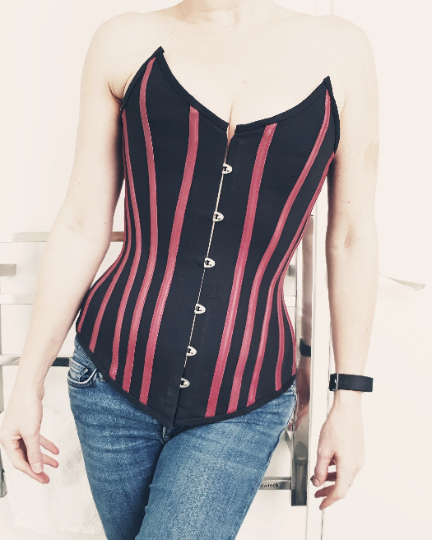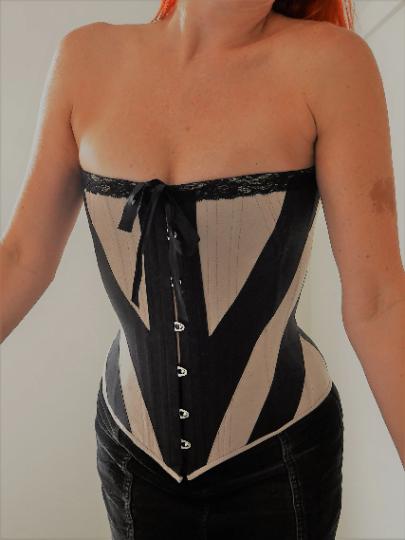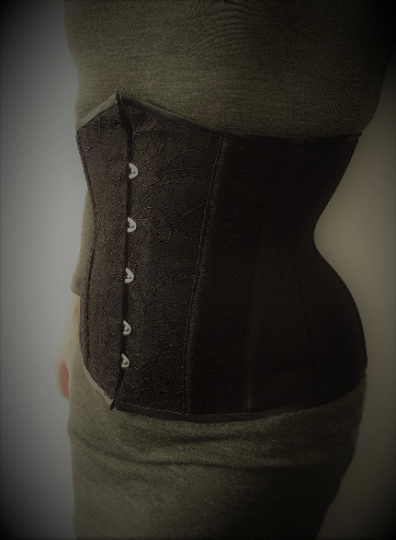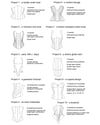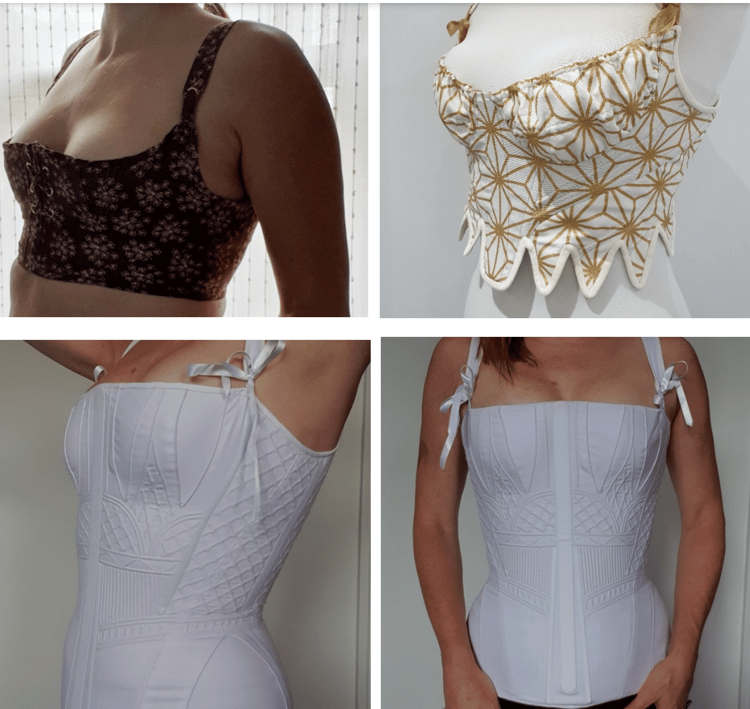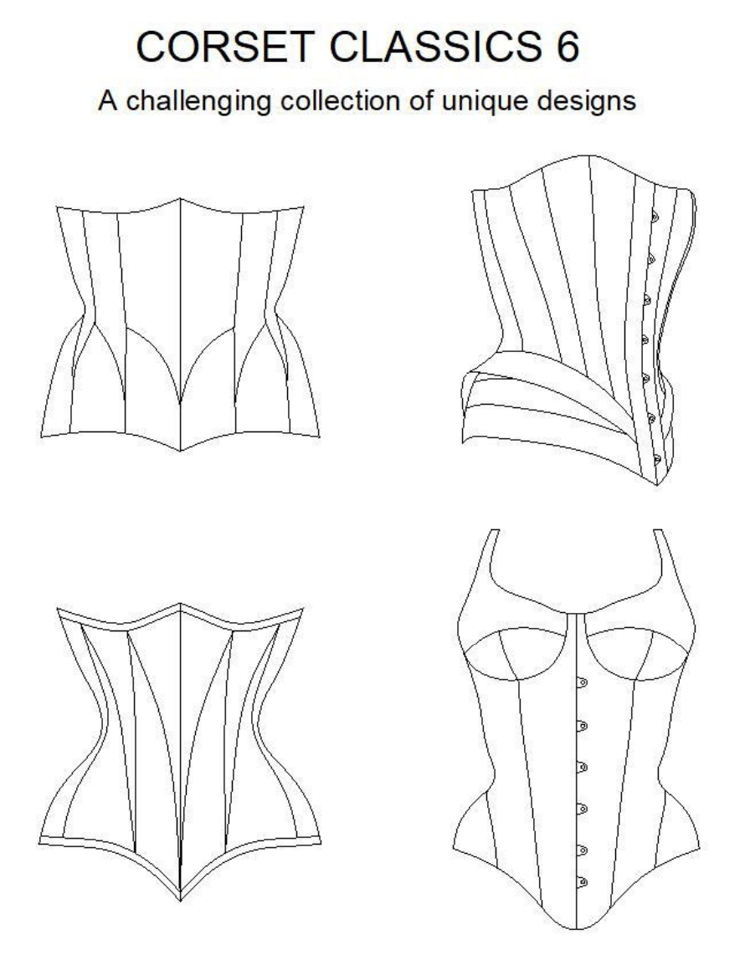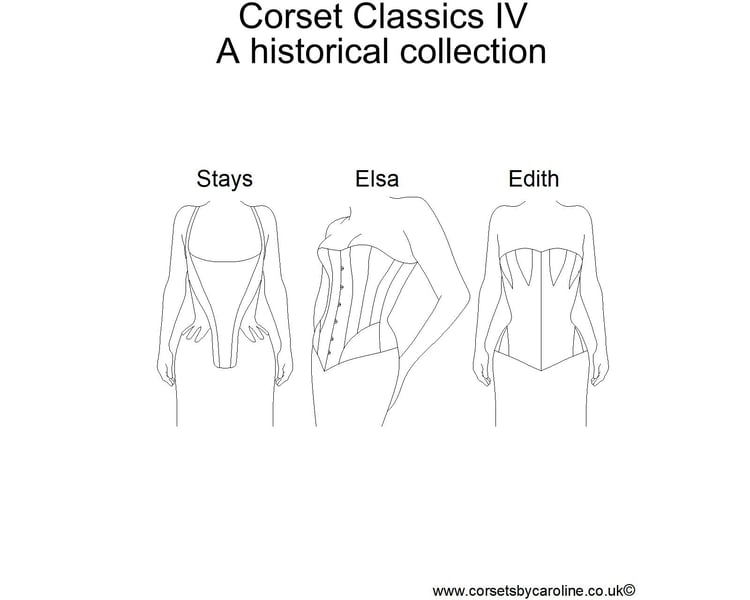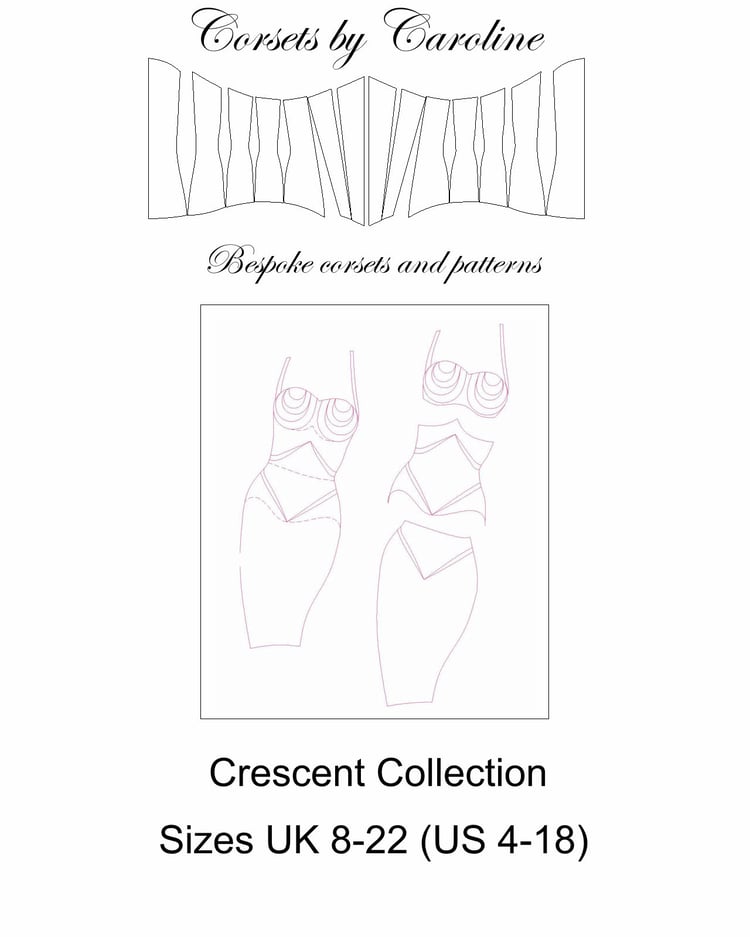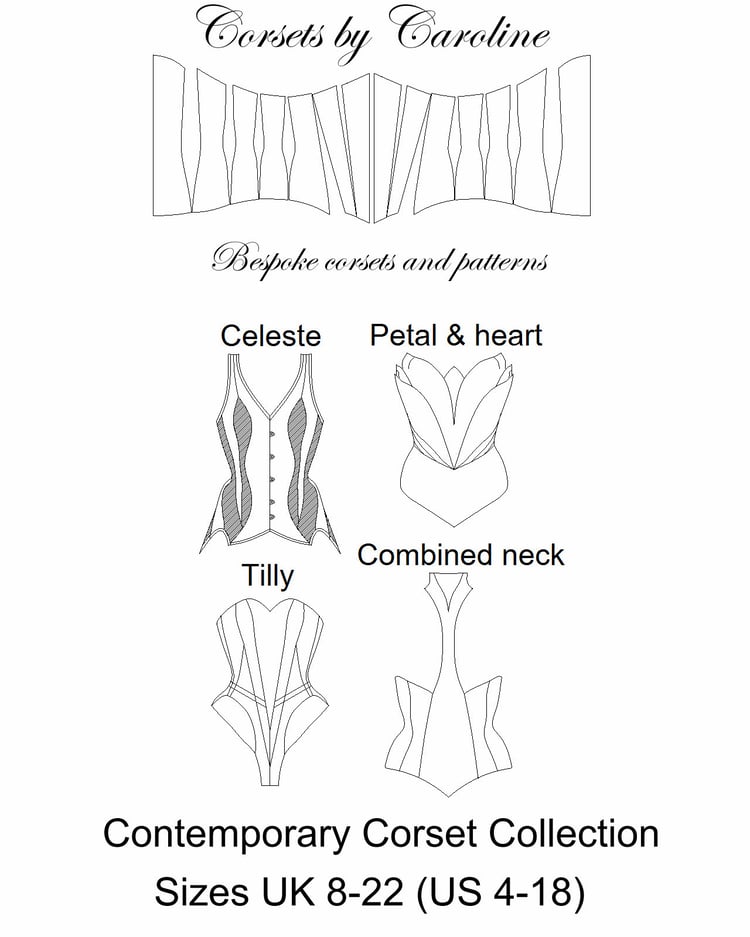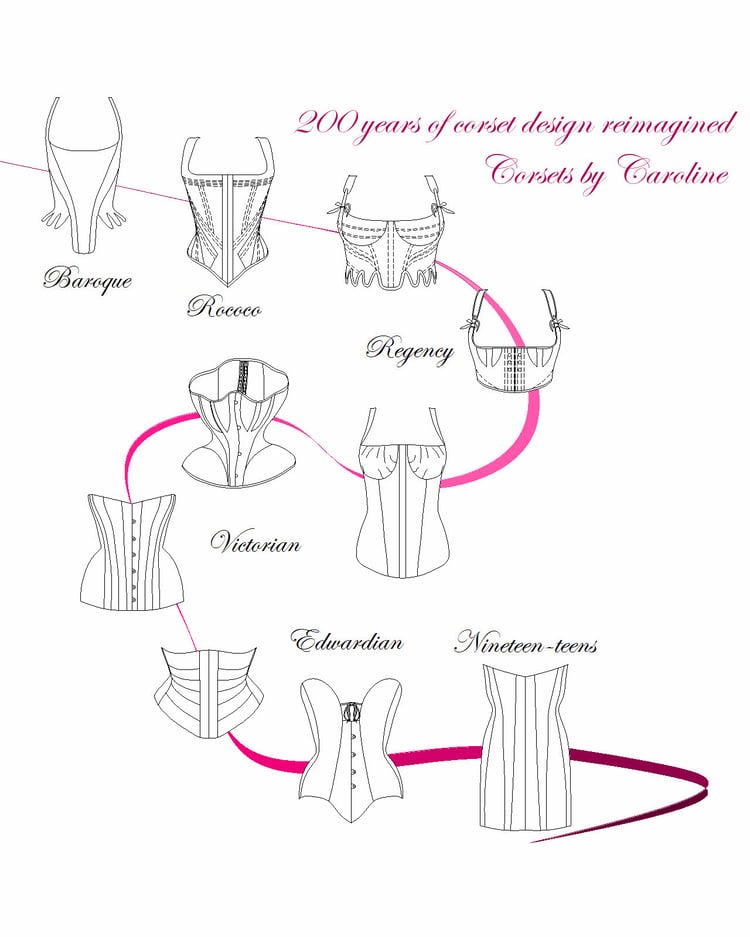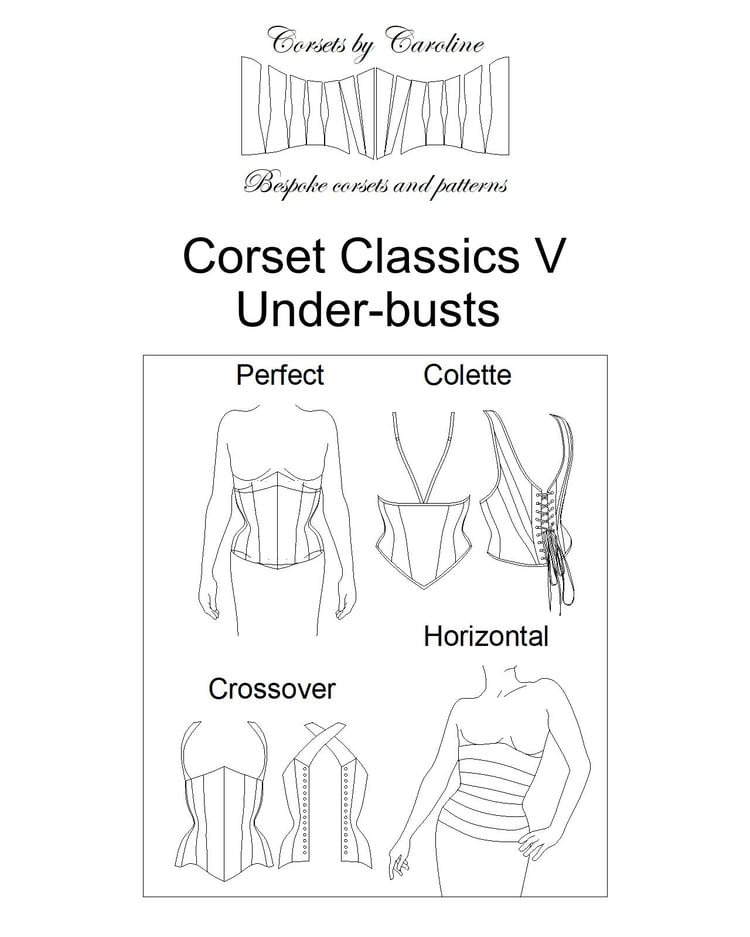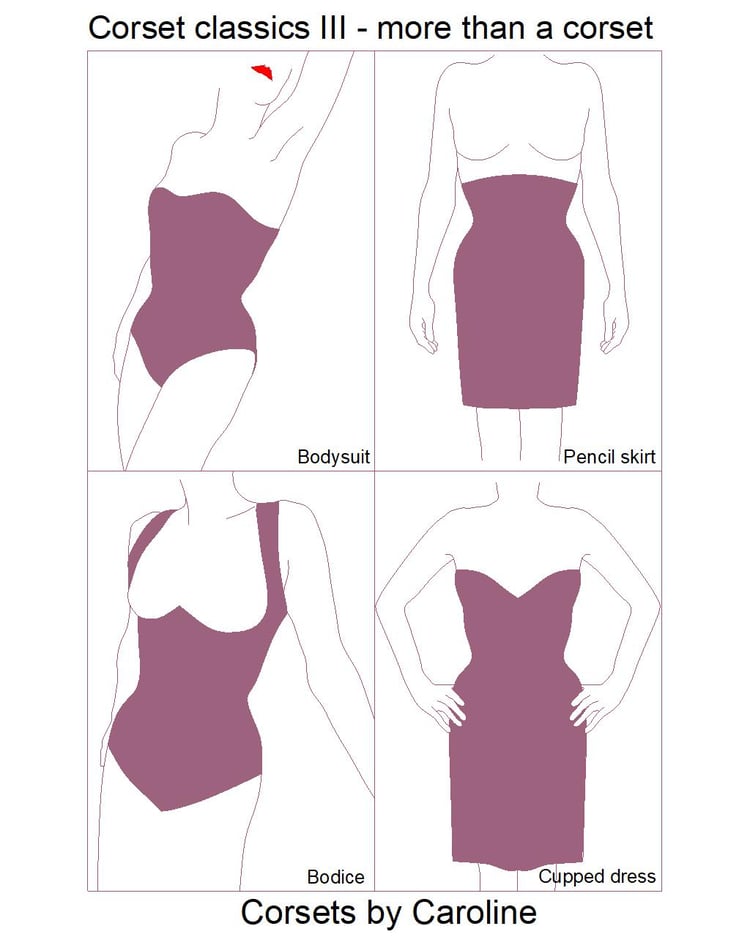Patterns (ten!) for curves - a modern corset makers' compendium
On Sale
£36.00
£36.00
This is an extensive pattern book with ten beautiful graded patterns to work through. Many different construction methods are described in detail with accompanying illustrative photos.
This compendium of ten patterns will take you forward in your learning and knowledge of the craft of corsetry. If you work through every pattern in the order they appear, you will learn a number of corsetry techniques and become proficient in corset making.
Project one - a simple under-bust: a simple single layer with boning channels contained within the flat-felled seams. Lots of information about how to adjust your pattern to fit (and for plus sizes). Busk insertion is also covered in this project. Sizes UK8-30 (US 4-26)
Project two - a Victorian style over-bust: a double layered folded welt construction. Two different variations of bust points! Sizes UK 8-24 (US 4-20)
Project three - Stays (c1715): the sandwich method of construction with partial or fully boned variations. Sizes UK8-22 (US4-18)
Project four – a gusseted Victorian: gussets and cording are introduced. Sizes UK8-26 (US 4-22).
Project five – an early Edwardian: diagonal seams and bust gores. Sizes UK8-20 (US 4-16).
Project six – a modern ‘plunge’ : my best selling pattern - modern and flattering. External boning is introduced here. UK6-34 (US 2-30)
Project seven – a strapped under-bust: a conical shaped supportive corset - quite long in the torso - use the skills learned in project 1 to shorten if necessary! Sizes UK10-20 (US 6-16).
Project eight – a girdle skirt: a stretch panel for comfort - based on a 1960's vintage girdle with a long-line skirt option. Sizes UK8-20 (US 4-16).
Project nine – a cupped corset: cups sized to a E (approx.) and all you need to know about inserting cups into a corset. Sizes UK 8-26 (US 4-22).
Project ten – a bodysuit - hip gussets and made with bobbinet (details of how to use mesh are explained as an alternative). Sizes UK8-22 (US4-18).
Closed waist measurements: simple unde-bust is 20-42'', the Victorian is 21-39'', stays 21-35'', the early Edwardian is 23-33'', the modern ones are 6: 22-48'', 7: 21-31'', 8: 22-34'', 9: 23-33'', 10: 21-35''
The importance of turn-of-cloth and all the quirks of corsetry are explained.
'It takes time to master the art of corsetry and as a consequence corsets are (or at least should be) expensive. Toiles are an absolute necessity (fittings can number two to three or more), precision is paramount, and there is a mass of knowledge necessary for a professional standard to be reached. Each corset can take from 20 – 200 hours depending on complexity and embellishment. Understanding anatomy, how fabrics behave and the best way to arrange panels and boning for fit are incredibly important. This craft cannot be learned in a weekend – a period of trial and error is unfortunately par for the course and many fall at this hurdle. In a time when juggling life is becoming increasingly difficult most people just do not have the time to make failure after failure and climb that steep learning curve. If, however, you realise you enjoy the challenge, you will be rewarded with a quality product that you have made yourself, and an incredible sense of achievement.'
Please take a look at my website www.corsetsbycaroline.co.uk where I have lots of information about corset making and where it is more cost-effective to buy this design (non EU countries only sorry).
About the author: Caroline Woollin is a designer specialising in corsetry. She has been developing exquisite and unusual patterns since 2014 has amassed more than 50 designs to her catalogue. Each design takes approximately one month to complete and involves painstaking experimentation into grainline and panel angles to arrive at the most wrinkle-free garment possible. Inspiration is from a variety of sources – original historical patterns play a part but often she just mashes shapes together in CAD to come up with new and exciting designs; triangular panels ending at points, corsets made entirely of gussets, gores in unusual juxtapositions, tiered hip fins with pockets. She is not afraid of trying completely new ways of doing things and frequently writes articles about her findings for platforms such as Foundations Revealed.
Why buy this book? Corsets were historically worn to create the fashionable silhouette of the day, to give bust support, and to hold up the weight of skirts (or stockings in the 20th century). Not all Victorians were tight-laced to the point of discomfort - maids wore corsets and went about their duties without hindrance. In the 1920’s however, a straight boyish silhouette contributed to the corset falling out of fashion, as did the later invention of the brassiere, although girdles were common until the 1970’s. These days everything goes – cosplaying and burlesque have all contributed to an increase in the interest in corsetry, and from reading the many forums on the subject, bust support and back problems are also cited as being the driver in the quest to learn. Some people just love the feeling of being hugged (the corset ‘hug’) – slight pressures in certain places can alleviate pain. An off-the-rack corset will never provide a perfect fit that will help with a persons’ idiosyncratic requirements. Moreover, different designs give different levels of comfort and for those new to wearing a corset, they may need some time to find their ultimate fit and become accustomed to it. Often, a number of different styles will need to be tried to arrive at a design that works – most people don’t have the budget to recruit a corset maker to do this for them, and learning themselves is the most economic option.
There are no restrictions on the use of these patterns - use to your heart's content. I simply ask that you don't pass on the file or use it to, say, profit from a line of ready-to-wear corsets.
This compendium of ten patterns will take you forward in your learning and knowledge of the craft of corsetry. If you work through every pattern in the order they appear, you will learn a number of corsetry techniques and become proficient in corset making.
Project one - a simple under-bust: a simple single layer with boning channels contained within the flat-felled seams. Lots of information about how to adjust your pattern to fit (and for plus sizes). Busk insertion is also covered in this project. Sizes UK8-30 (US 4-26)
Project two - a Victorian style over-bust: a double layered folded welt construction. Two different variations of bust points! Sizes UK 8-24 (US 4-20)
Project three - Stays (c1715): the sandwich method of construction with partial or fully boned variations. Sizes UK8-22 (US4-18)
Project four – a gusseted Victorian: gussets and cording are introduced. Sizes UK8-26 (US 4-22).
Project five – an early Edwardian: diagonal seams and bust gores. Sizes UK8-20 (US 4-16).
Project six – a modern ‘plunge’ : my best selling pattern - modern and flattering. External boning is introduced here. UK6-34 (US 2-30)
Project seven – a strapped under-bust: a conical shaped supportive corset - quite long in the torso - use the skills learned in project 1 to shorten if necessary! Sizes UK10-20 (US 6-16).
Project eight – a girdle skirt: a stretch panel for comfort - based on a 1960's vintage girdle with a long-line skirt option. Sizes UK8-20 (US 4-16).
Project nine – a cupped corset: cups sized to a E (approx.) and all you need to know about inserting cups into a corset. Sizes UK 8-26 (US 4-22).
Project ten – a bodysuit - hip gussets and made with bobbinet (details of how to use mesh are explained as an alternative). Sizes UK8-22 (US4-18).
Closed waist measurements: simple unde-bust is 20-42'', the Victorian is 21-39'', stays 21-35'', the early Edwardian is 23-33'', the modern ones are 6: 22-48'', 7: 21-31'', 8: 22-34'', 9: 23-33'', 10: 21-35''
The importance of turn-of-cloth and all the quirks of corsetry are explained.
'It takes time to master the art of corsetry and as a consequence corsets are (or at least should be) expensive. Toiles are an absolute necessity (fittings can number two to three or more), precision is paramount, and there is a mass of knowledge necessary for a professional standard to be reached. Each corset can take from 20 – 200 hours depending on complexity and embellishment. Understanding anatomy, how fabrics behave and the best way to arrange panels and boning for fit are incredibly important. This craft cannot be learned in a weekend – a period of trial and error is unfortunately par for the course and many fall at this hurdle. In a time when juggling life is becoming increasingly difficult most people just do not have the time to make failure after failure and climb that steep learning curve. If, however, you realise you enjoy the challenge, you will be rewarded with a quality product that you have made yourself, and an incredible sense of achievement.'
Please take a look at my website www.corsetsbycaroline.co.uk where I have lots of information about corset making and where it is more cost-effective to buy this design (non EU countries only sorry).
About the author: Caroline Woollin is a designer specialising in corsetry. She has been developing exquisite and unusual patterns since 2014 has amassed more than 50 designs to her catalogue. Each design takes approximately one month to complete and involves painstaking experimentation into grainline and panel angles to arrive at the most wrinkle-free garment possible. Inspiration is from a variety of sources – original historical patterns play a part but often she just mashes shapes together in CAD to come up with new and exciting designs; triangular panels ending at points, corsets made entirely of gussets, gores in unusual juxtapositions, tiered hip fins with pockets. She is not afraid of trying completely new ways of doing things and frequently writes articles about her findings for platforms such as Foundations Revealed.
Why buy this book? Corsets were historically worn to create the fashionable silhouette of the day, to give bust support, and to hold up the weight of skirts (or stockings in the 20th century). Not all Victorians were tight-laced to the point of discomfort - maids wore corsets and went about their duties without hindrance. In the 1920’s however, a straight boyish silhouette contributed to the corset falling out of fashion, as did the later invention of the brassiere, although girdles were common until the 1970’s. These days everything goes – cosplaying and burlesque have all contributed to an increase in the interest in corsetry, and from reading the many forums on the subject, bust support and back problems are also cited as being the driver in the quest to learn. Some people just love the feeling of being hugged (the corset ‘hug’) – slight pressures in certain places can alleviate pain. An off-the-rack corset will never provide a perfect fit that will help with a persons’ idiosyncratic requirements. Moreover, different designs give different levels of comfort and for those new to wearing a corset, they may need some time to find their ultimate fit and become accustomed to it. Often, a number of different styles will need to be tried to arrive at a design that works – most people don’t have the budget to recruit a corset maker to do this for them, and learning themselves is the most economic option.
There are no restrictions on the use of these patterns - use to your heart's content. I simply ask that you don't pass on the file or use it to, say, profit from a line of ready-to-wear corsets.
